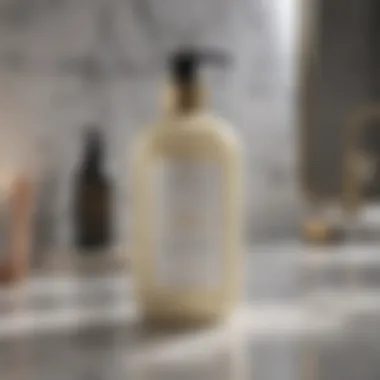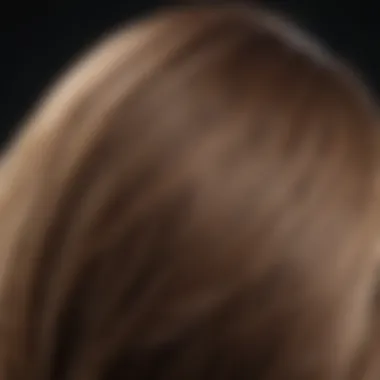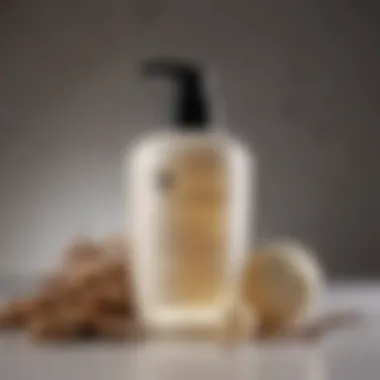Top Conditioners for Dry Hair: A Comprehensive Guide


Intro
Dry hair is a common concern for many women, often characterized by its coarse texture and lackluster appearance. There are several reasons behind the development of dry hair, including environmental factors, excessive styling, heat damage, and inadequate moisture retention. Understanding these causes is crucial before exploring the available conditioning solutions. This article seeks to provide a comprehensive analysis of leading conditioners specifically formulated to combat dryness and restore hair vitality.
Conditioners play an essential role in any hair care routine, especially for those with dry hair. They work to replenish moisture, improve manageability, and enhance overall shine. Selecting the right conditioner can significantly affect the health and appearance of your hair.
In the following sections, we will discuss trending topics in hair care, step-by-step guides on conditioners for dry hair, and detailed product reviews of the best items available on the market. This guide aims to equip you with the knowledge to make informed choices and enhance your hair care routines.
Understanding Dry Hair
Understanding dry hair is fundamental to making informed decisions about hair care. Dry hair can lead to several issues like brittleness, split ends, and lack of luster. Identifying its characteristics and causes can guide women towards better hair treatment options, especially when selecting conditioners.
Characteristics of Dry Hair
Dry hair often feels rough to the touch and lacks moisture. Its texture can be coarse and may appear dull or lifeless. Most noticeably, dry hair may be frizzy, and flyaways are common. When observing dry hair, it may also break easily during styling or combing. The key characteristics can include:
- Tangle-prone: Dry hair can be difficult to comb or style due to its roughness.
- Brittleness: Hair strands may break or snap easily, causing uneven lengths.
- Dullness: It often lacks shine, appearing lifeless.
- Frizz: Dry hair can lead to increased frizz, especially in humid conditions.
- Split Ends: The tips of dry hair strands can split, making a trim necessary more frequently.
Understanding these characteristics enables better choices in hair products, particularly conditioners designed to hydrate and rejuvenate.
Common Causes of Dryness
Dry hair does not occur without reason. Recognizing the common causes can help in battling this condition effectively. Several factors contribute to hair dryness:
- Environmental Factors: In particular, low humidity, sun exposure, and harsh weather can sap moisture from hair.
- Chemical Treatments: Frequent dyeing, perming, or using harsh shampoos can strip hair of its natural oils.
- Heat Styling: Using tools like hair straighteners and curling irons often can lead to moisture loss.
- Health Issues: A deficiency in essential nutrients, dehydration, or certain medical conditions may also cause hair to dry out.
- Age Factors: As individuals age, natural oil production decreases, leading to drier hair.
To prevent and treat dry hair effectively, understanding these causes is crucial. They guide the selection of appropriate conditioners and treatment strategies for healthier hair.
The Role of Conditioners
Conditioners play a critical role in the maintenance and rejuvenation of dry hair. They are not just an optional part of hair care but a necessity for anyone looking to improve the health and appearance of their locks. Understanding the significance of conditioners can help individuals make informed choices about their hair products and care routines.
Why Conditioning Is Essential
Conditioning hair is vital for several reasons. First, it helps to restore moisture lost during washing. Shampoos often strip natural oils, leading to further dryness. Conditioners work to replenish these oils, providing the necessary hydration that hair requires.
Additionally, they enhance manageability. Dry hair can become tangled and frizzy, making styling difficult. Using a conditioner can smooth the hair shaft, reducing friction and allowing for easier combing and styling.
Moreover, conditioners can protect the hair from environmental damage. They create a barrier against pollutants, UV rays, and heat from styling tools. This protective layer helps maintain the hair's integrity and can prevent breakage and split ends.
In summary, conditioning is not just about making hair feel soft; it supports the overall health of the hair and scalp. It is an essential process that should not be overlooked.
How Conditioners Work
Understanding the mechanics of how conditioners work can demystify some of the benefits they offer. Conditioners typically contain ingredients that bond to the hair shaft, creating a protective layer. This layer helps to seal moisture in and prevent further damage.
Conditioners often contain emollients like silicones, which coat the hair, providing shine and smoothness. This coating effect also plays a role in detangling and reducing static. Some conditioners include humectants, which draw moisture from the air, helping to keep the hair hydrated even in dry conditions.
Another important aspect is the pH balance of conditioners. Most conditioners are formulated to be slightly acidic. This acidity helps to close the cuticle of the hair, creating a smooth surface that reflects light, enhancing shine, and reducing frizz.


Key Ingredients to Look For
Selecting a conditioner for dry hair is a multifaceted process that requires attention to the ingredients included in the formula. Certain components contribute significantly to the effectiveness of a conditioner, especially for those with dry hair. Understanding these ingredients will help you choose products that not only nourish but also revitalizes your locks, leaving them hydrated and manageable.
Moisturizing Agents
Moisturizing agents are fundamental in any conditioner meant for dry hair. These ingredients help to retain water in the hair, ensuring that it is hydrated and soft. Common moisturizing agents include glycerin, aloe vera, and panthenol. Glycerin attracts moisture from the environment into the hair shaft. Aloe vera offers soothing properties, which can calm irritated scalp and hair. Panthenol, a derivative of vitamin B5, can penetrate the hair, adding softness and shine.
It is advisable to look for conditioners that list these agents prominently in the ingredient list. They enhance the conditioner’s ability to restore moisture without weighing the hair down. This is crucial, as some conditioning agents can leave residue, which may make the hair seem dull and heavy rather than vibrant and bouncy.
Proteins and Their Benefits
Proteins play an essential role in the care of dry hair. They help repair the structure by filling in gaps in the hair shaft, providing strength and resilience. Common proteins found in conditioners include hydrolyzed silk, keratin, and wheat proteins. Each of these carries unique benefits.
- Hydrolyzed silk: This ingredient imparts a silky texture and enhances shine.
- Keratin: Known for its protective properties, it can help restore dry and damaged hair.
- Wheat proteins: These offer flexibility and reduce breakage, ensuring that the strands remain intact.
Using a conditioner that incorporates these types of proteins can greatly benefit your hair, especially if it experiences breakage or frizz due to dryness. Regular use can lead to more manageable hair that is less prone to damage.
Natural Oils vs Synthetic Oils
The debate between natural oils and synthetic oils in hair care is ongoing. Both have their advantages and disadvantages when it comes to conditioning dry hair. Natural oils, such as argan oil, coconut oil, and jojoba oil, are often preferred for their nourishing properties. They provide hydration from natural sources and can improve the hair’s overall texture.
On the other hand, synthetic oils can offer specific benefits, such as lock-in moisture more effectively. Ingredients like dimethicone form a protective barrier that prevents moisture loss, which can be crucial for dry hair types. However, some may find synthetic oils heavy or greasy on their hair.
In summary, consider the needs of your hair when choosing between these types of oils. Look for conditioners that balance both natural and synthetic ingredients to find the optimal solution for your dry hair needs.
Important Note: Always check the labels for potential allergens or irritants, particularly if you have sensitive skin.
Incorporating the right ingredients can make a noticeable difference in how your hair appears and feels. Therefore, understanding these key components is vital to making informed choices about conditioners.
Top Conditioners for Dry Hair in the Market
Selecting the right conditioner is crucial for maintaining the health and vitality of dry hair. These conditioners not only provide moisture, but they also help to replenish the hair's natural oils and protect against environmental damage. The choice of conditioner can significantly impact the overall appearance and manageability of hair. In a market saturated with products, it is important to understand what distinguishes effective conditioners for dry hair.
Many factors contribute to a conditioner’s effectiveness, including its formulation, the presence of beneficial ingredients, and the specific needs of the individual’s hair type. For those with dry hair, a focus on hydration, nourishment, and protection is essential. Below are some of the standout conditioners available, each catering to unique goals and preferences.
Conditioner A: Overview and Benefits
Conditioner A is formulated with deep-moisturizing ingredients such as shea butter and argan oil. These components are known for their rich fatty acid profiles, which help to seal in moisture and restore the hair's natural luster. The benefits of this conditioner include:
- Enhanced hydration for dry and brittle hair.
- Improved elasticity, reducing breakage during styling.
- A smooth, silky finish without weighing the hair down.
Using Conditioner A regularly can lead to softer hair that is easier to manage, making it a top choice for daily use.
Conditioner B: Overview and Benefits
Conditioner B prides itself on its gentle, sulfate-free formulation. This conditioner contains oat extracts that soothe the scalp while adding hydration. The advantages of Conditioner B include:
- Safe for color-treated and sensitive hair types.
- Mild enough for daily use without stripping natural oils.
- Provides a lightweight feel, avoiding buildup that can dull hair.
This conditioner addresses dry hair while maintaining the integrity of color treatments, making it suitable for a wider audience.


Conditioner C: Overview and Benefits
Conditioner C incorporates protein-rich ingredients such as hydrolyzed keratin, which fortifies and strengthens dry hair. Users can expect benefits like:
- Restoration of damaged hair, enhancing its structure.
- Improved shine and moisture retention.
- Feel of thicker, healthier-looking hair after consistent use.
For individuals facing significant damage, Conditioner C is an excellent option due to its dual action of conditioning and repairing.
Conditioner D: Overview and Benefits
Conditioner D takes a more natural approach, with ingredients like coconut oil and avocado oil. These oils deeply penetrate the hair shaft, providing intense hydration. The key benefits include:
- Rich nourishment that revitalizes and renovates dull hair.
- Enhanced manageability, leading to fewer tangles.
- Protection against heat damage from styling tools.
Conditioner D is ideal for those who prefer organic ingredients and seek deep nourishment.
Conditioner E: Overview and Benefits
Conditioner E stands out with its infusion of botanical extracts such as chamomile and lavender, promoting a soothing experience during application. This conditioner offers:
- Calming effects on the scalp, useful for those with sensitivity.
- Antioxidant properties that help combat environmental stressors.
- Hydration without the greasy feel, allowing for easy styling.
For users who are not only concerned about moisture but also the health of their scalp and overall hair environment, Conditioner E provides a holistic solution.
Effective conditioning is not solely about moisturizing; it’s also about understanding what your hair needs for recovery and vitality.
By evaluating these conditioners, one can make informed choices based on personal hair needs, allowing for the best outcomes in the pursuit of healthy, vibrant hair.
How to Choose the Right Conditioner
Choosing the right conditioner is crucial for maintaining healthy hair. This selection process goes beyond merely picking a product off the shelf. It involves understanding your hair's specific characteristics and what it genuinely needs for improvement. The right conditioner can make a significant difference in the moisture balance, shine, and overall health of your hair. Thus, it is essential to take the time to consider various factors that will guide this decision.
Assessing Your Hair Type
Identifying your hair type is a fundamental step in choosing a suitable conditioner. Hair can be categorized as straight, wavy, curly, or coily. Each type has unique properties that affect how it reacts to moisture and products. For example:
- Straight Hair tends to be oily but may suffer from dryness due to heat styling.
- Wavy Hair often requires a conditioner that provides moisture without weighing it down.
- Curly Hair usually benefits from rich, hydrating formulas to combat dryness and frizz.
- Coily Hair requires deep conditioning products that penetrate the hair shaft for moisture and strength.
Understanding your hair type enables you to select a conditioner that caters specifically to its needs, ensuring better results in moisture retention and overall health.
Identifying Your Hair Needs
Once your hair type is established, the next step is to identify your hair’s specific needs. Dry hair can be caused by several factors, including damage from heat styling, environmental stressors, and improper care. Here are some elements to consider:
- Moisture Levels: Determine if your hair feels brittle, lacks elasticity, or appears dull. If so, you need a conditioner that focuses on moisture replenishment.
- Damage Repair: If your hair has experienced breakage or split ends, look for conditioners that offer protein or strengthening capabilities to repair and reinforce the hair structure.
- Scalp Health: A healthy scalp is essential for healthy hair. If you experience dryness or irritation, consider conditioners with soothing properties or natural ingredients that promote scalp health.
- Frequency of Styling: For those who frequently use heat styling tools or coloring products, a richer, nourishing conditioner is beneficial for added protection and moisture.
By carefully assessing your hair type and its specific needs, you can make a more informed choice in selecting a conditioner that not only addresses dryness but also enhances the overall appearance and health of your hair.
"Choosing the right conditioner is about understanding your hair's unique traits and needs. This approach ensures better results and long-term health.”


Through this process of assessment, you will find the optimal conditioner tailored for you. This journey toward well-nourished hair is not just about products; it is also about understanding the very essence of your hair.
Application Techniques
Proper application techniques are essential for ensuring that conditioners work effectively on dry hair. Understanding how to apply conditioner can make a significant difference in the overall health and moisture content of your locks. The method of application, the quantity used, and the timing are all key components that contribute to the performance of a conditioner. When done right, these techniques maximize the product’s ability to hydrate, nourish, and improve the overall texture of your hair.
How to Properly Apply Conditioner
Applying conditioner correctly is vital for achieving the best results. Here are some steps to follow:
- Start with Clean Hair: Always apply conditioner on freshly washed hair. Use a gentle shampoo that does not strip your hair of its natural oils.
- Squeeze Excess Water: After rinsing shampoo, gently squeeze your hair to remove excess water. This helps the conditioner to adhere better without being overly diluted.
- Apply from Mid-Length to Ends: Focus on the lower sections of your hair, where dryness typically occurs. Avoid applying conditioner directly on the scalp to prevent greasiness.
- Use a Wide-Tooth Comb: To ensure even distribution, use a wide-tooth comb to gently comb through your hair after applying the conditioner. This helps in detangling and ensures that every strand is coated.
- Leave-In Time: Follow the instructions on the product label regarding how long to leave the conditioner in your hair before rinsing. This allows the ingredients to penetrate the hair shaft.
- Rinse with Cool Water: Finish by rinsing your hair with cool water. This closes the hair cuticles and enhances shine, giving your hair a smoother look.
Applying conditioner effectively ensures that your hair receives the maximum benefits.
Frequency of Use
Determining how often to use conditioner is essential for maintaining healthy hair. Many people with dry hair benefit from using conditioner regularly, as it replenishes moisture and provides essential nutrients. However, the frequency can depend on hair type, activity level, and product formulas. Here are some guidelines:
- Daily Use: For those with extremely dry or damaged hair, a moisturizing conditioner can be used daily. Look for lightweight formulas that won't weigh your hair down.
- Every Wash: If you wash your hair every 2-3 days, applying conditioner each time will help maintain moisture levels and protect against environmental damage.
- Weekly Deep Conditioning: In addition to regular conditioner, incorporate a deep conditioning treatment once a week. This can provide an intensive moisture boost when needed most.
- Listen to Your Hair: Pay attention to how your hair feels. If it starts to feel weighed down or greasy, consider reducing the frequency.
Overall, the right application techniques combined with a proper frequency of use are essential for ensuring that your conditioner delivers the intended results on dry hair.
Additional Care for Dry Hair
Taking care of dry hair goes beyond just using the right conditioners. It involves a holistic approach that reinforces hair health and prevents further damage. Dry hair can lead to frizz, split ends, and breakage, affecting not only appearance but also hair strength. Addressing this issue with additional care steps is essential for maintaining vibrancy and texture. Therefore, understanding additional care tactics is important in this article as it complements the conditioning process.
Recommended Hair Masks
Hair masks serve as intensive treatments designed to provide nourishment and hydration to dry hair. These products contain concentrated ingredients that penetrate deeper than regular conditioners. Regular use of hair masks can significantly enhance moisture levels and improve overall hair condition.
Here are some key benefits of incorporating hair masks into your routine:
- Deep Conditioning: Hair masks offer richer emollients than typical conditioners, providing a more thorough conditioning treatment.
- Repair Damage: Many masks contain proteins that can help repair damaged hair and promote healing.
- Enhance Shine: Regular use can enhance hair's natural shine, making it look healthier and more vibrant.
When selecting a hair mask, pay attention to essential ingredients such as argan oil, shea butter, and keratin. These elements have proven benefits in terms of moisture retention and damage repair. Masks should ideally be used once a week or set as part of a self-care routine, depending on the level of dryness.
Protective Styles to Consider
Protective hairstyles are another effective method for managing dry hair. These styles shield hair from environmental stressors and reduce the manipulation that often leads to damage and dryness. Here are some protective styles to consider:
- Braids: These can be simple or intricate depending on personal preference. Braids protect hair ends, which are the oldest and most prone to damage.
- Buns: High or low buns can keep hair tucked away and minimized exposure to the elements. They work well for creating a polished look while protecting strands.
- Twists: Like braids, twists minimize handling and allow for moisture retention, making them ideal for dry hair care.
Adopting protective styles can relieve daily hair stressors and lower maintenance efforts. Before styling, consider using a leave-in conditioner or oil for additional moisture. This adds an extra layer of protection against dryness.
In summary, adding hair masks and adopting protective styles are two significant considerations for those dealing with dry hair. These elements work hand in hand with conditioners to offer a comprehensive approach to hair care. By following these practices, you can improve the health and appearance of your hair, making it more resilient to future dryness.
Ending
In the realm of hair care, understanding conditioners tailored for dry hair is vital. This guide serves to underscore the significance of selecting the right products that nourish and hydrate. Each element discussed is key to enhancing hair health, particularly for individuals plagued by dryness. The exploration of each conditioner, coupled with the insights into their ingredients and application techniques, empowers readers with knowledge.
Recap of Key Points
- Dry hair possesses distinct characteristics, often resulting from environmental factors, heat styling, or chemical treatments. Understanding these traits helps in addressing specific needs effectively.
- Conditioners play a pivotal role in restoring moisture and strength to dry hair. Their formulation, comprising various beneficial ingredients, serves different objectives, from deep hydration to increased manageability.
- Key ingredients in conditioners include moisturizing agents, proteins, and oils, each contributing uniquely to hair care. Knowing what these components do is essential for selecting the best product.
- The suggested conditioners in this guide cater to various preferences and budgets, making it easier to find suitable options.
- Proper application techniques and frequency of use are crucial in achieving desired results. They ensure that the conditioning treatment is effective and maintains hair quality over time.
- Additional care, such as using hair masks and opting for protective styles, complements the use of conditioners, leading to overall healthier hair.
Encouragement for Personalization
Personalization is paramount when it comes to hair care. What works for one person may not suit another due to different hair types, textures, and specific conditions. Therefore, experimenting with different conditioners and techniques is part of the journey. Adjusting routines and being attentive to how your hair responds will allow for informed decisions. Remember, taking care of dry hair involves a personalized approach that considers individual needs and preferences. Stay open to discovering new products and methods that enhance your hair’s appearance and health.



